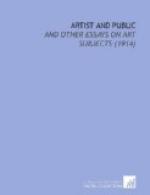Obviously, there are two courses open to the painter. If he is a modern by feeling and by training, full of curiosity and of the scientific temper, caring more for the investigation of the aspects of nature and the rendering of natural light and atmosphere than for the telling of a story or the construction of a decoration, he will, if he is able enough, treat his matter much as Sargent has treated it. The figure will become, for him, only an incident in the landscape. It will be important only as a thing of another texture and another color, valuable for the different way in which it receives the light and reflects the sky, just as rocks and foliage and water and bare earth are valuable. For to the true Impressionist light and atmosphere are the only realities, and objects exist only to provide surfaces for the play of light and atmosphere. He will abandon all attempt at rendering the material and physical significance of the human form and will still less concern himself with its spiritual significance. He will gain a great vividness of illusion, and he may console himself for what he loses with the reflection that he has expressed the true relation of man to the universe—that he has expressed either man’s insignificance or man’s oneness with nature, according as his temper is pessimistic or optimistic.
If, on the other hand, the painter is one to whom the figure as a figure means much; one to whom line and bulk and modelling are the principal means of expression, and who cares for the structure and stress of bone and muscle; if the glow and softness of flesh appeal strongly to him; above all, if he has the human point of view and thinks of his figures as people engaged in certain actions, having certain characters, experiencing certain states of mind and body; then he will give up the struggle with the truths of aspect that seem so vital to the painter of the other type and, by a frank use of conventions, will seek to increase the importance of his figure at the expense of its surroundings. He will give it firmer lines and clearer edges, will strengthen its light and shade, will dwell upon its structure or its movement and expression. He will so compose his landscape as to subordinate it to his figure and will make its lines echo and accentuate that figure’s action or repose. When he has accomplished his task he will have painted not man insignificant before nature but man dominating nature.
For an example of this way of representing man’s relation to the world about him, let us take Titian’s “Saint Jerome” (Pl. 22)—a picture somewhat similar to Sargent’s in subject and in the relative size of the figure and its surroundings. Titian has here given more importance to the landscape than was common in his day. He also has meant, as Sargent has, to make a great deal of the wilderness to which his saint has retired, and to make his saint a lonely human being in a savage place. But the saint and his emotion is, after all, what interests




